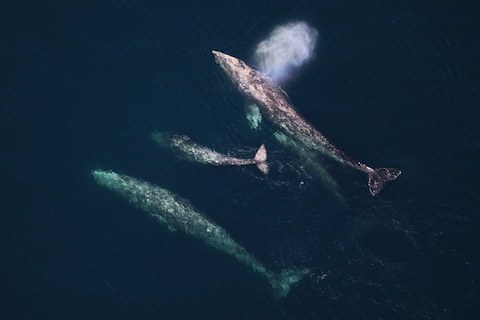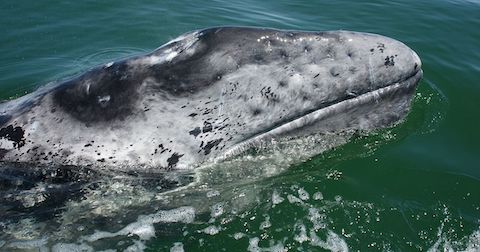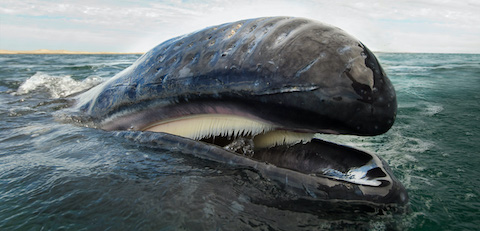
Credit: Nicholas Metheny/NOAA/NMFS Permit No. 20465
California gray whales, like several other whale species, migrate from arctic feeding grounds in summer to warm equatorial waters in winter to birth their young.
This migration can be more than 13,000 miles—the longest on Earth.
Scientists think they may use magnetoreception, navigating according to Earth’s magnetic field.
New findings somewhat corroborate that, but with a wrinkle we can’t explain.
It’s not uncommon that whales will get lost or injured along the route, strand themselves on the coast, and die.
A third of the dead whales found are emaciated, suggesting they starved.
Some researchers hypothesize that their population, which, remarkably, has rebounded to pre-whaling numbers, has simply reached the carrying capacity of their environment.
Others suggest warming polar seas might be producing less food for them.
But some of these dead whales were perfectly healthy and may have simply become disoriented. Scientists wondered why.
They studied stranding events going back 30 years and found nearly 200 healthy whales had beached.
Looking for correlations, they found this was four times as likely to happen during periods of high sunspot activity.
Sunspots that merely disrupted Earth’s magnetic field didn’t appear unusually fatal. But sunspots that also released bursts of radio static seemed to interfere with the whales’ sense of navigation, perhaps blocking their ability to read magnetic signals…
Or interfering with some new navigational sense we don’t yet understand.
Background
Synopsis: California gray whales had a bad year in 2019, with many times more strandings than had been seen in the previous two decades. The cause appears to be starvation on the return trip of their long migration from Alaska to Mexico and back, which might be attributed to decreased availability of the whales’ most nutritious prey in Alaskan waters or to whale population numbers pushing up against the carrying capacity of the environment. But even healthy gray whales strand themselves sometimes. The cause may be radio frequency blasts from solar activity, which appears to shut down the whales’ navigational sensors.

Credit: Getty Images
- In an earlier EarthDate episode, we learned that the ancestors of whales left the oceans about 360 million years ago but then reversed course and returned to the marine ecosystem about 50 million years ago. This required amazing physiological adaptations.
- We also found out that there are two types of whales: filter feeders called baleen whales and carnivorous toothed whales.
- Whales typically migrate toward warmer equatorial waters where their calves are born in winter, and toward cooler polar water in summer. Because many whale species migrate in the open ocean, some scientists think they might use Earth’s magnetic field for navigation—although this has not been proven.
- California gray whales (Eschrichtius robustus) are baleen whales that grow up to 50 ft (15 m) in length and may weigh up to 40 tons (36 metric tons). They typically live between 55 and 70 years.
- They are gray with white patches caused by scarring from parasites. The distinctive scars can be used to identify specific individuals.
- They are characterized by a short, creamy white baleen and two blowholes which make a heart-shaped “blow” when they exhale at the surface.
- Gray whales are the sole living species in their genus and family, another “lonely species” like others we have described on EarthDate.
- They mate in November and December, and in mid-January—after 13.5 months of gestation—the 13-ft-long (4 m) calves are born tail-first in the lagoons of Mexico.
- The calves consume 50–80 lb (23–36 kg) of their mothers’ milk, which is 53% fat, per day. This can be a nutritional drain for the mothers.
- The mothers with calves head north toward their feeding grounds along the coast of Alaska when the calves are ready, usually from March until mid-April but possibly extending into May.
- These whales navigate close to shore for more than 10,000–13,700 mi (16,000–22,000 km) during their annual migration to and from the Bering and Chukchi Seas of Alaska and back to Mexico’s Gulf of California.
- They average about 75 mi (120 km) per day.
- This migration is thought to be the longest migration of any mammal.

A gray whale opens its mouth, showing off hundreds of baleen plates.
Credit: Christopher Swann - As filter feeders, gray whales take in great mouthfuls of mud or water and filter them through hundreds of baleen plates made up of fingernail-like keratin combs, expelling the sediment and water and swallowing the marine life that remain trapped inside their mouths.
- In their feeding grounds, they tend to feed on shrimp-like crustaceans (amphipods) floating near the surface by turning on their sides and skimming the surface of the water with open mouths. If crustaceans are not available, the whales will feed on krill, which are less calorie dense.
- While migrating, they feed on coastal bottom-dwelling crustaceans by turning on their sides in shallow water and taking in huge mouthfuls of fine mud.

Credit: NOAA Fisheries
Credit: NOAA Fisheries

Credit: NOAA Fisheries
- An increase in strandings and deaths of gray whales in 2019 (122 in the U.S. and 214 in Canada) has scientists very concerned.
- NOAA Fisheries declared an Unusual Mortality Event (UME) on May 31, 2019. UMEs are defined as “a stranding that is unexpected, involves a significant die-off of any marine mammal population, and demands immediate response.”
- The strandings are occurring on the whales’ spring northbound trip from their calving area in Mexico to their feeding grounds in Alaska.
- A similar event lasted 2 years in 1999 and 2000 with 651 deaths recorded.
- About 35% of the carcasses discovered in 2019 were emaciated. This suggests most of the deaths may have been caused by starvation, but more research on other possible causes is needed. Researchers note that weakened whales are more prone to boat strikes and entanglement in fishing nets.
- Researchers believe the dying whales have insufficient fat reserves to make it through their annual migrations because they are not getting enough nutrition before heading south from their Alaskan summer feeding grounds. Gray whales eat much less during the migration and winter season in Mexico.
- Some theorize that changes in sea ice have reduced amphipod populations in the Alaskan waters and coastal muds, requiring the whales to hunt less-nutritious krill instead.
- Others suggest that the population of about 27,000 gray whales—which has recovered to levels seen before commercial whaling days—is at the normal limit of what the environment is capable of supporting for the species.

Credit: NASA
- But sometimes, even perfectly healthy gray whales are stranded. A recent study has established that healthy gray whales are 4.3 times as likely to strand themselves on land during times of high sunspot activity.
- Some of Earth’s creatures use its magnetic field to navigate, and although researchers are not certain that whales use magnetoreception, some aspects of increased sunspot activity seem to disrupt the whales’ ability to navigate.
- Since this species tends to migrate nearer to shore, navigational errors pose greater consequences for them.
- 31 years of data (1985–2018) on gray whale strandings was analyzed, excluding cases in which whales were malnourished, injured, sick, or entangled. That left 186 strandings of healthy whales to consider.
- When compared to solar activity records, these strandings were found to be 4.3 times as frequent during solar events characterized by a lot of radio-frequency noise. However, the whales didn’t strand more frequently when solar storms simply displaced the magnetic field without an associated burst of radio frequencies.
- The exact reason behind these findings is not yet fully understood, but the observation is that whales are able to navigate safely if solar activity simply distorts the magnetic field, unless an outburst with high solar radio flux occurs. The radio frequencies appear to overwhelm the whales’ ability to navigate, making whatever navigational sensor they use effectively “blind.”

